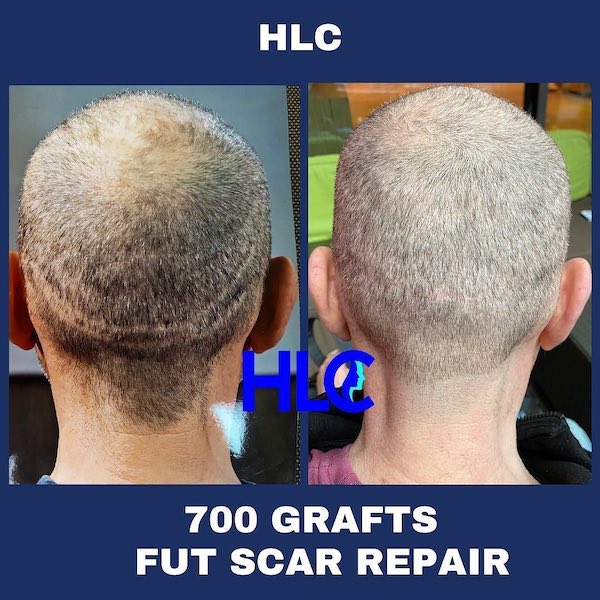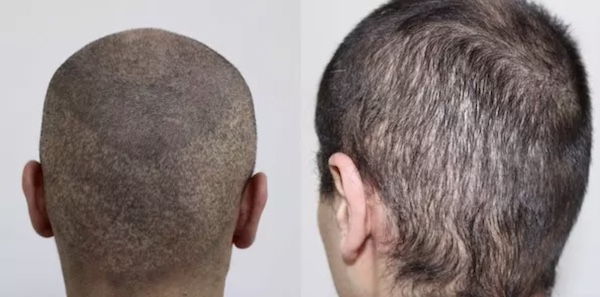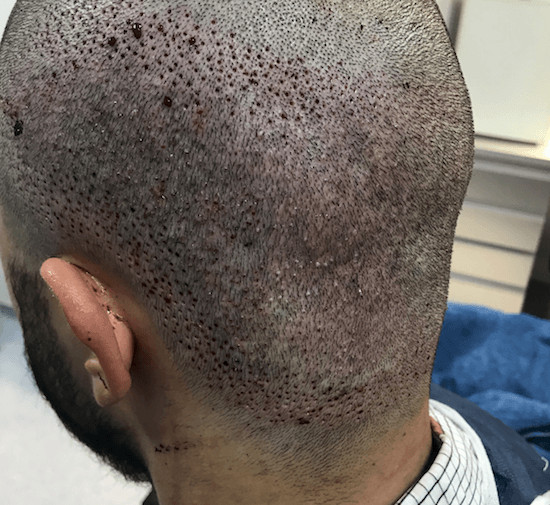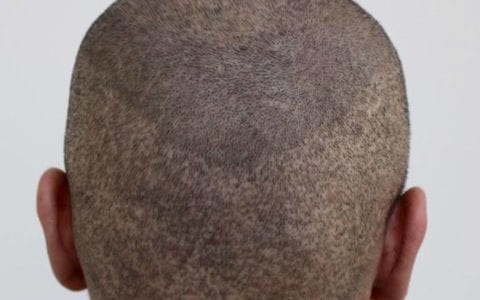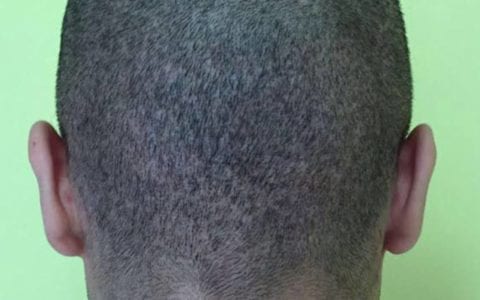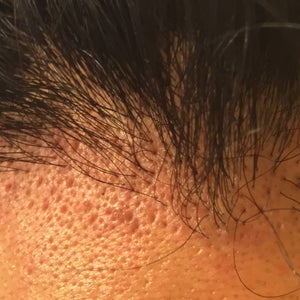The number of botched hair transplants is increasing rapidly. If a hair transplant is not performed professionally, this can lead to permanent scars.
In the case of a hair transplantation with the strip hair transplant technique to wider linear scars that make a short haircut impossible and in the case of a transplantation with the FUE technique, it can come not only to many scars, but also to completely decimated hair rings and this goes so far that possibly after only one failed FUE hair transplantation no further operation is possible. In the following we would like to show some examples of scars after a hair transplantation, but also inform you whether and how they can be corrected.
Scars after FUT (strip hair transplantation)
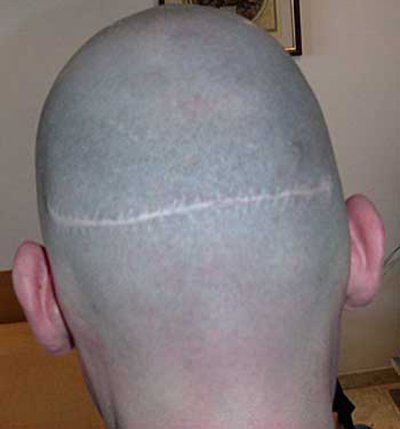
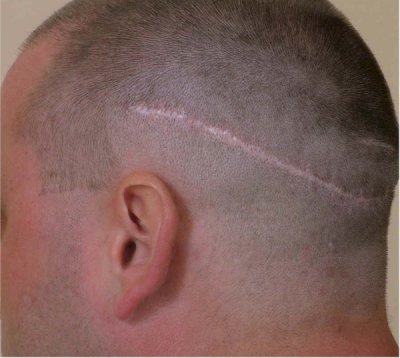
If an FUT hair transplantation is carried out by experienced hair surgeons and ideal conditions are present, good wound healing, little scarring, good elasticity of the scalp, then the chances are good that only a pencil-wide scar of e.g. 1-2 mm will develop and right short haircuts of clearly less than 1 cm are still possible at the level of the scar after the transplantation.
Further improvement of FUT scars with the Trichophytic Closure technique – hair grows through the scar
For some years now, hair surgeons have increasingly used a technique for FUT hair transplants which improves the optical situation after the FUT operation and after the wound/scar has healed; this is the “Trichophytic-Closure” method.
The basic idea is that hair grows through the later scar and thus the linear scar is visually much less conspicuous and thus shorter hair is also possible.
According to Dr Mario Marzola1 from Australia, this method dates back to the Yuri Flap technique2 .
According to Dr Mario Marzola, this technique was already mentioned by the Australian doctor Dr Rosenbaum at the ISHR meeting in San Francisco in 1999, in which the tip of the epidermis was removed when closing the wound after the FUT operation and this had led to significantly improved scars in his practice after years of use1.
The Trico closure has also been described previously by Dr Patrick Frechet and Dr Paul Rose.3
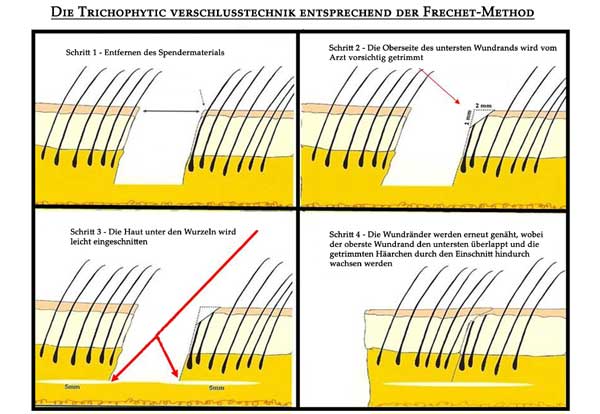
Overall, the trichophytic closure technique has brought enormous improvements, but even this special method cannot make a FUT scar completely invisible.
Successful scar treatment: correction/repair of linear scars caused by FUT surgery using FUE hair transplantation
Scars resulting from FUT hair transplantation (strip) can be planted with FUE. A correction/repair is often successful and visually beautiful with improvements, although here, too, high growth rates cannot be guaranteed due to scarring and possibly poorer blood circulation. In addition, the scar is always present and is only slightly covered. Nevertheless, many corrections/repairs with FUE treatments are successful and the patients are satisfied with the results. The following is an example of an FUE scar treatment (scar correction/scar repair) with 700 grafts from Hairlineclinic in Turkey:

Correction-repair of a FUT scar by removing the scarring
Another way to improve linear scarring after FUT hair transplantation can be achieved by cutting out the scar and closing it again. It is hoped that this will make the scar significantly narrower. However, experience has shown that there is a risk that the scar will gradually pull apart again and may ultimately not be much narrower than before the correction.
Scars after FUE hair transplantation
After an FUE hair transplant, if not performed professionally, large scarring in the ring of hair and completely decimated donor areas.
If the grafts are removed electronically with the help of so-called micromotors, especially cheap micromotors that were not developed for hair transplantation and are misused, there is not only the risk of scars, but also the great risk of excessively removed areas that resemble a window in the case of inexperienced persons performing the procedure (inexperienced doctors and/or inexperienced and unlicensed assistants). In addition to the likelihood of grafts being damaged, there is also the risk of relatively too many grafts being taken and massive overharvesting, which leads to very unattractive visual damage and also ruins the donor reserves in the ring of hair.
An example of a classic scar look after failed FUE hair transplantation with window look:
Permanent scars in the ring of hair/donor and discouraging examples of cases from the ISHRS
As part of the Fight is Fight campaign, ISHRS.org5 has published some cautionary case studies, with a thorough warning about low-cost hair transplant clinics, where in many cases pure mass processing takes place and often by inexperienced and unlicensed assistants:
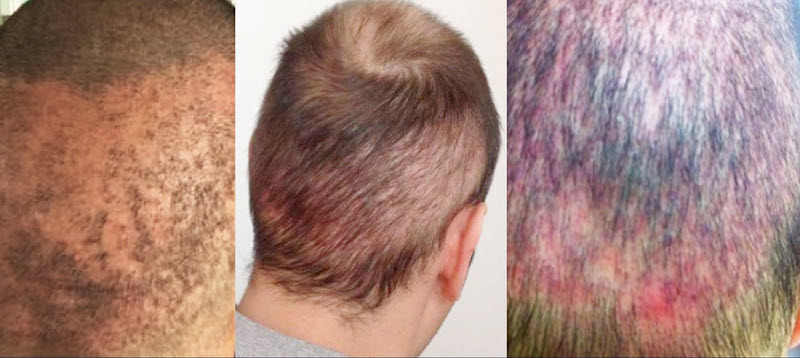

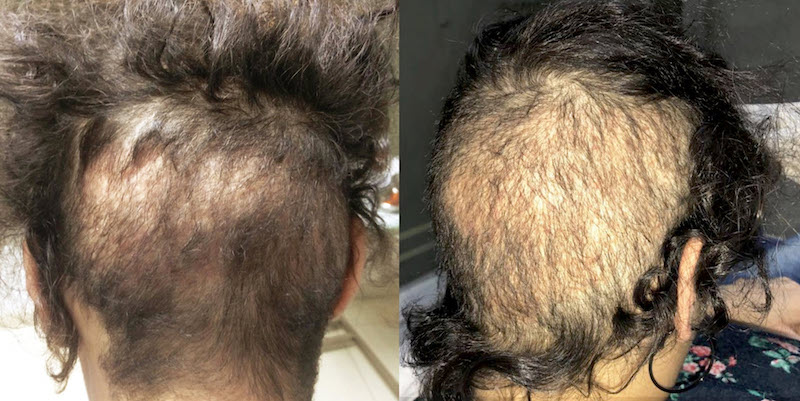
Correction and repair of depleted FUE donor areas – Donor Restocking
In order to repair/correct a depleted hairline, there are the possibilities of donor restocking or donor replenishment. Either more hair is taken from the ring of hair in areas that are still densely grown and then placed in the sparse ring of hair/donor area, or hair is taken from the body (BHT) or beard area and placed in the sparse areas. It is important to know that the growth rates can be significantly lower in bad cases, as transplantation is usually carried out into scars which may have poorer blood supply.
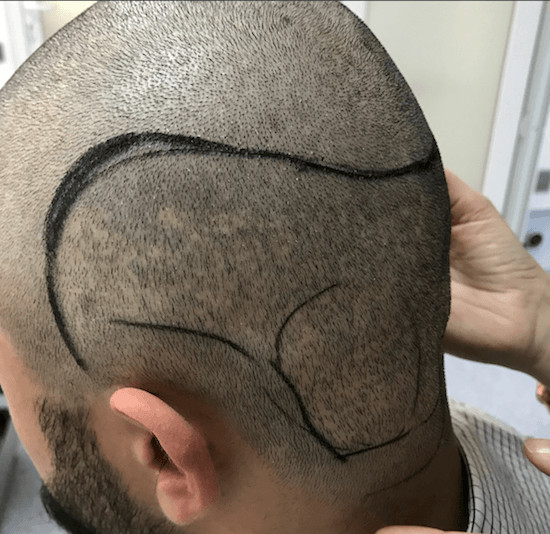
Pigmentation/hair pigmentation/SMP as optical correction in decimated donor areas by FUE
Another possibility to visually improve/correct a depleted donor area is pigmentation/hair pigmentation/SMP, or also called scalp pigmentation. This is a visual improvement comparable to permanent make-up (similar to a tattoo). However, it is not a permanent solution and the procedure needs to be repeated regularly after a few months. In addition, the fine dots may run into each other after some time, similar to hatching, or the color may change. It is advisable to seek detailed advice before pigmentation.
Scarring in the recIPIENT area
Not only in the donor area, but also in the recipient area, scars (scarring) can result from an unprofessionally performed hair transplant.
Pitting and cobblestoning: unwanted scarring, dimples and hillocks
Very undesirable side effects of a failed hair transplant are often pitting, cobbelstoning and at the same time often associated scarring.
Pitting means a significant deepening and cobblestoning means a significant elevation around the grafts.
Correction/repair of pitting and cobblestoning
According to Dr Samuel M. Lam9 of the Lam Institute for Hair Transplantation in Plano, Texas, USA, pitting is the result of grafts being placed too deep and cobblestoning is the result of grafts being placed too high. In both cases, however, correction/repair is problematic and difficult. In the case of pitting, the holes can be removed by punching excisions or some grafts can be transplanted into the spaces in between to cover the holes somewhat. In the case of cobblestoning, the higher part of the skin can be separated flush with the scalp, or additional grafts can also be transplanted to cover them.
FAQ`S REGARDING HAIR TRANSPLANTATION SCARS AND SCAR TISSUE FORMED AFTER HAIR TRANSPLANTATION NOT PERFORMED PROFESSIONALLY
No. A complete removal of the hair transplant scars (whether caused by the FUT or FUE technique) is not possible. It is possible to cut out the scars or scar area caused by FUT strip hair transplantation and close the wound again, in the hope that less scar (scar area/scar tissue) will develop as before. However, there is a risk that the scar will stretch again after some time and may not be much narrower than the scar before. FUE scar tissue can also not be removed.
Yes, a scar, whether caused by an accident or on scars/scar tissue caused by the FUT or FUE technique, can be transplanted or hair can be transplanted into/onto the scar, either from the normal ring of hair or also with BHT/beard hair. In many cases, the hair grows well. However, the growth rate may be lower depending on how well the scar is circulated.
There is only the possibility to conceal (cover) or optimise damaged (depleted) donor areas either by scalp pigmentation/scalp pigmentation, or by donor restocking (hair replenishment of the donor). With donor restocking, either by transplanting hair in still dense donor areas to non-dense areas, or by transplanting BHT (body hair) or hair from the beard/beard area into the non-dense donor areas. However, donor restocking involves transplanting into scar tissue/scars and the growth rate may be lower if the blood flow in the scar tissue is less.
No, with every hair transplantation there are in fact scars, no matter which technique is used. Advertising by providers with terms such as hair transplantation without scars is factually not possible. Every hair transplantation, including the minimally invasive FUE method, results in scars.
Yes, on scars resulting from FUE or FUT surgery, pigmentation/hair pigmentation/SMP or also called scalp pigmentation can be performed. However, the procedure must be repeated regularly, tattooed dots may run into each other over time (similar to hatching) and the colour may change. You should get good advice on this beforehand.
Quelle/Referenzen/Autor
1 https://www.iahrs.org/q-a/trichophytic-closure
2 https://aibolita.com/surgical-treatment/51580-juri-flap.html
3 https://www.researchgate.net/publication/283365452_Trichophytic_closure
4 https://www.feriduni.com/images/FUT/FUT_Trichophytic_Closure_technique.pdf
5 https://fightthefight.ishrs.org
6 https://fightthefight.ishrs.org/beware-risks/
7 https://www.realself.com/question/los-angeles-ca-the-treatment-for-pitted-skin-hairline
8 https://www.realself.com/question/nebraska-city-ne-fix-cobblestoning-shaving-hair-fix
9 Dr. Samuel M. Lam, MD, Plano, Texas, USA https://www.facialplastic.theclinics.com/article/S1064-7406(13)00099-0/pdf



